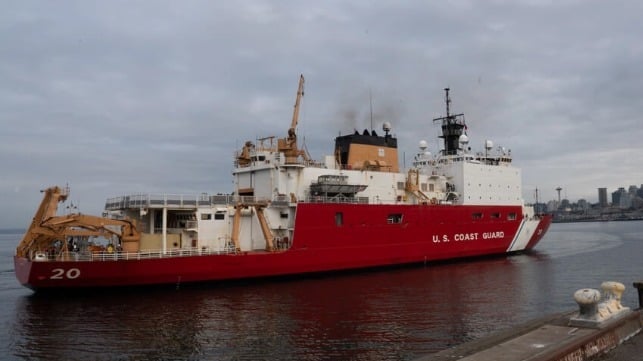USCG Polar Icebreaker Healy Returns to Seattle After Fire Suspends Mission

The U.S. Coast Guard’s polar icebreaker Healy returned to Seattle prematurely on August 16, approximately two months into her 2024 mission after having suffered a fire. The Coast Guard's statement is downplaying the incident saying that no one was injured, and the return is out of “an abundance of caution.”
The vessel deployed on June 13 on her mission which was planned for three stages. She was in the first phase, which called for her to operate in the Pacific and the Beaufort Sea, north of Alaska, and conduct a broad-scale survey of the boundary current system from the Bering Strait to the western Canadian Arctic.
The fire occurred the Coast Guard is confirming on July 25 while in the vicinity of Banks Island, Northwest Territories, Canada. The report says that the Healy’s crew and contractors restored power to the affected motor, but the cutter returned to Seattle to “ensure all redundant systems are fully operational before returning to the Arctic.”
In a written statement, Capt. Michele Schallip, Healy’s commanding officer said, “While transiting to a collection site, we suffered a fire on a transformer. I am immensely proud of the crew for quickly extinguishing the fire and limiting damage to that equipment.”
The Coast Guard is emphasizing that the Healy’s crew and embarked researchers conducted more than 150 conductivity, temperature, and depth (CTD) casts to investigate the circulation and properties of the water, monitored for signs of harmful algal blooms, and collected observations on marine mammals and birds in the Bering, Chukchi, and Beaufort Seas. Additionally, two subsurface moorings were deployed that are equipped with multiple sensors collecting oceanographic data on the physical, chemical, and biological state of the Arctic Ocean.
Leaving the Arctic means that the U.S. does not have a presence in the region during the critical research period while other countries are active there. The U.S. currently only has the Healy which is now 25 years old and the Polar Star which has been in service for 48 years and currently is undergoing a life extension overhaul. Construction of the next generation of polar icebreakers is significantly over budget and delayed and the USCG is moving toward acquiring and activating a commercial vessel, but it will not be in service till 2026.
Speaking in Washington, D.C. Coast Guard Admiral Kevin Lundy confirmed that the age of the Healy could make repairs difficult. He said that the equipment is “antiquated,” and that replacement parts were not readily available.

that matters most
Get the latest maritime news delivered to your inbox daily.
It is not the first time the Healy has suffered a life-threatening fire. In July 2020, she caught fire while 60 nautical miles off Seward, Alaska on her way to the Arctic. It was an electrical fire which was extinguished in 30 minutes, but one of her motors was badly damaged. She spent the winter of 2020-2021 in dry dock receiving a new motor that had been built for her in 1999 and stored for over 20 years.
The Healy is designed to break 4.5 feet of ice continuously at three knots and can operate in temperatures as low as -50 degrees Fahrenheit. The USCG has not indicated if she can resume her mission. She was scheduled to embark 20 early career polar scientists and their mentors on a Polar Chief Scientist Training Cruise in the second portion of her 2024 mission and finally to support the Global Ocean Ship-Based Hydrographic Investigations Program (GO-SHIP), which aims to make the first ever single ship, single season, high-resolution transect of hydrographic observations across the Arctic basin.
